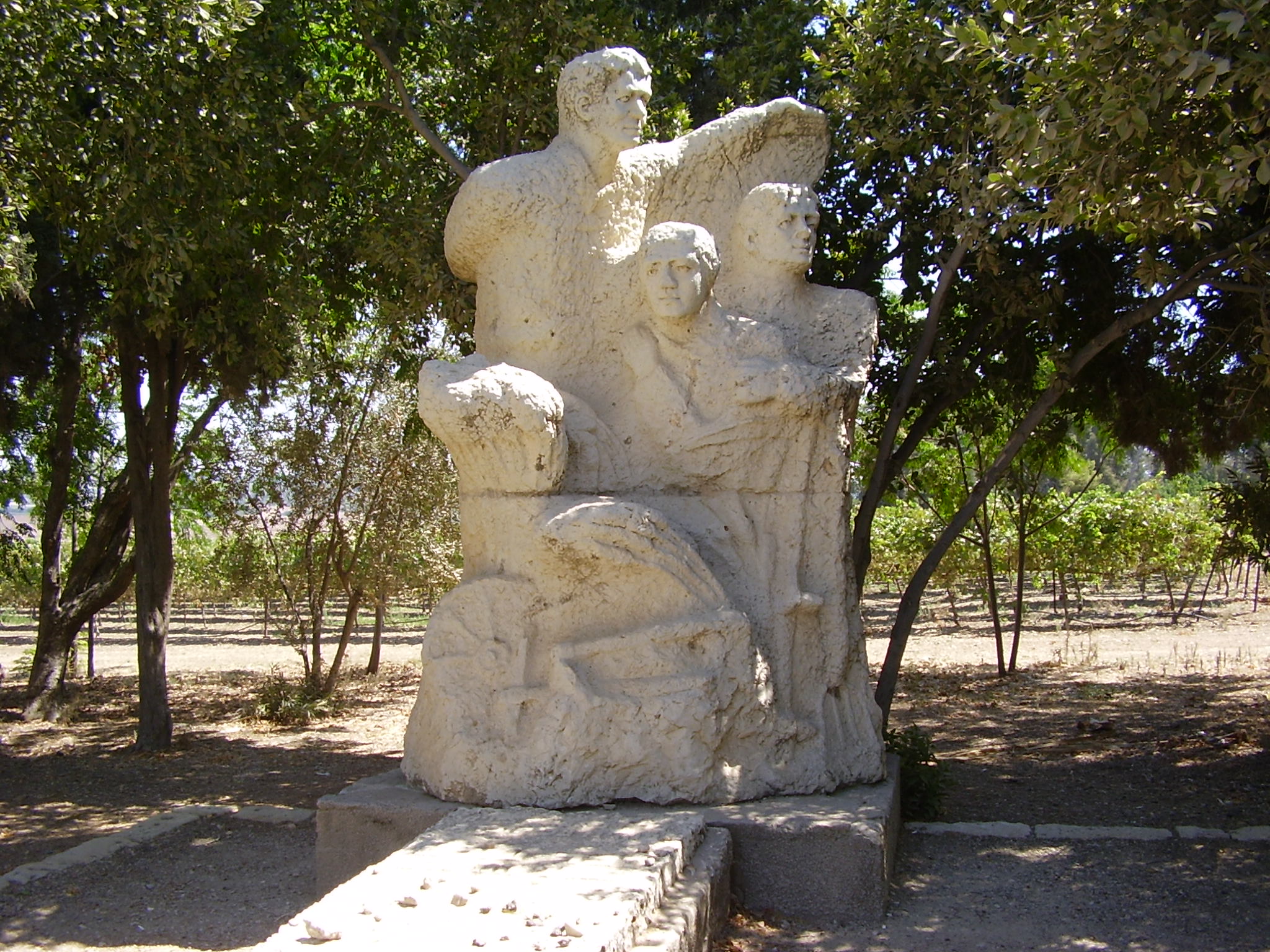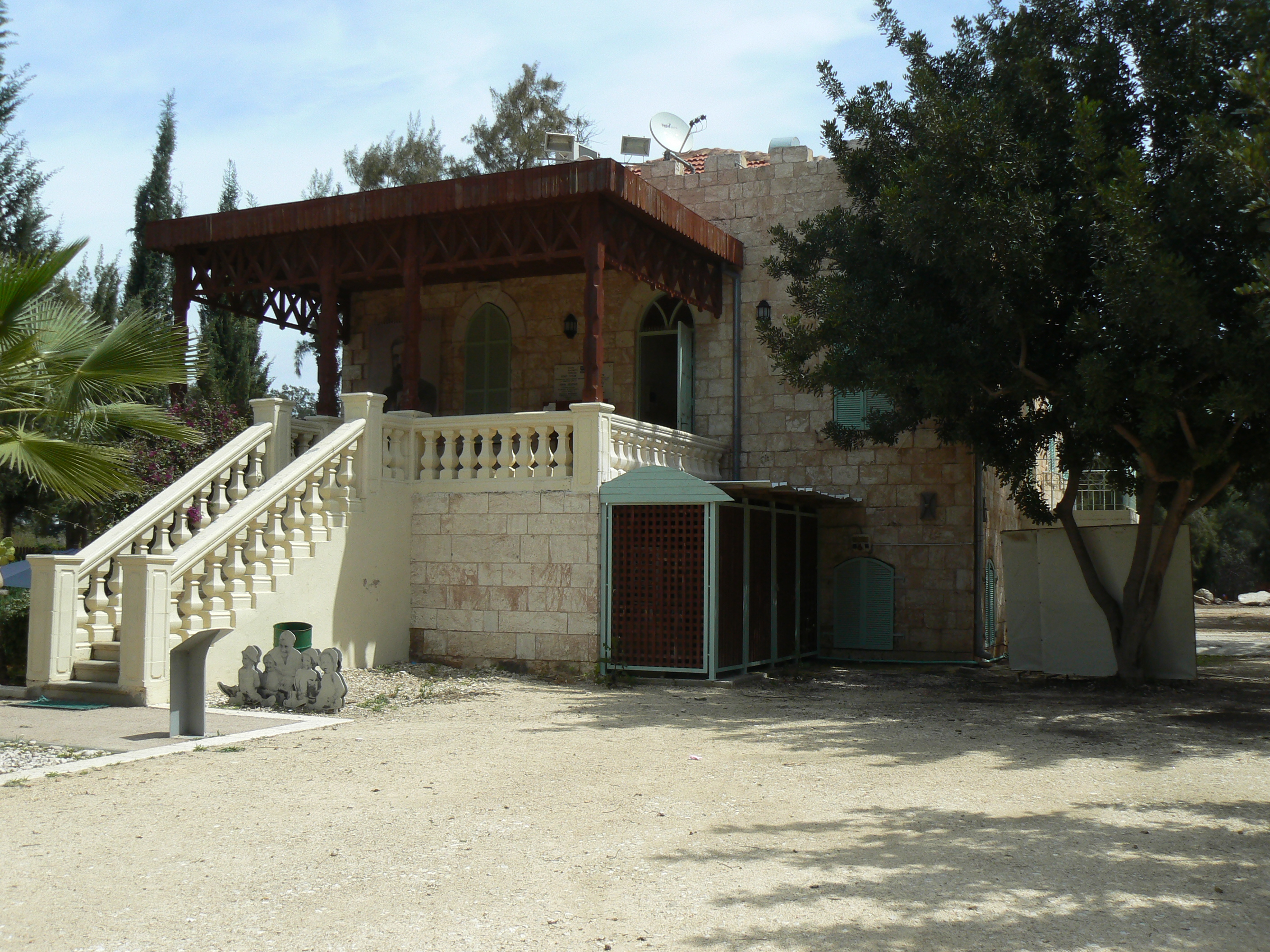Hulda, Israel on:
[Wikipedia]
[Google]
[Amazon]
Hulda ( he, חֻלְדָּה) is a

/ref>
20
/ref> The farm suffered several more attacks during the

File:חולדה - בראשיתה.-JNF034917.jpeg, Hulda 1936
File:Harel in Hulda.jpg, Members of the Harel Brigade preparing to move from Hulda to Jerusalem in April 1948
File:Harel Nachshon.jpg, Members of the Harel Brigade assembling prior to Operation Nachshon in April 1948
File:Hulda 1905.jpg, Original 1905 building: a neglected ruin in 1948
President to President, Jerusalem Post
/ref>
 *
*
Official website
{{Authority control Kibbutzim Kibbutz Movement Populated places in Central District (Israel) 1929 Palestine riots
kibbutz
A kibbutz ( he, קִבּוּץ / , lit. "gathering, clustering"; plural: kibbutzim / ) is an intentional community in Israel that was traditionally based on agriculture. The first kibbutz, established in 1909, was Degania. Today, farming h ...
in central Israel
Israel (; he, יִשְׂרָאֵל, ; ar, إِسْرَائِيل, ), officially the State of Israel ( he, מְדִינַת יִשְׂרָאֵל, label=none, translit=Medīnat Yīsrāʾēl; ), is a country in Western Asia. It is situated ...
. Located in the Shephelah
The Shephelah or Shfela, lit. "lowlands" ( hbo, הַשְּפֵלָה ''hašŠǝfēlā'', also Modern Hebrew: , ''Šǝfēlat Yəhūda'', the "Judaean foothills"), is a transitional region of soft-sloping rolling hills in south-central Israel str ...
near the Hulda Forest and the Burma Road
The Burma Road () was a road linking Burma (now known as Myanmar) with southwest China. Its terminals were Kunming, Yunnan, and Lashio, Burma. It was built while Burma was a British colony to convey supplies to China during the Second Sino-J ...
, it falls under the jurisdiction of Gezer Regional Council
Gezer Regional Council ( he, מועצה אזורית גזר, ''Mo'atza Azorit Gezer'') is a regional council in the Central District of Israel. Established in 1949, it had a population of 20,700 in 2006.
List of settlements
The council covers fi ...
. In it had a population of .
Etymology
The kibbutz takes its name from thePalestinian
Palestinians ( ar, الفلسطينيون, ; he, פָלַסְטִינִים, ) or Palestinian people ( ar, الشعب الفلسطيني, label=none, ), also referred to as Palestinian Arabs ( ar, الفلسطينيين العرب, label=non ...
village of Khulda, which existed nearby until the 1948 Arab–Israeli War
The 1948 (or First) Arab–Israeli War was the second and final stage of the 1948 Palestine war. It formally began following the end of the British Mandate for Palestine at midnight on 14 May 1948; the Israeli Declaration of Independence had ...
.
History

Ottoman rule
In 1905, the Anglo Palestine Bank purchased of land from the Saidun tribe for a Jewish settlement near theJaffa–Jerusalem railway
The Jaffa–Jerusalem railway (also J & J) is a railway that connected Jaffa and Jerusalem. The line was built in the Mutasarrifate of Jerusalem (Ottoman Syria) by the French company ''Société du Chemin de Fer Ottoman de Jaffa à Jérusalem et P ...
. Ownership of the land was transferred to the Jewish National Fund
Jewish National Fund ( he, קֶרֶן קַיֶּימֶת לְיִשְׂרָאֵל, ''Keren Kayemet LeYisrael'', previously , ''Ha Fund HaLeumi'') was founded in 1901 to buy and develop land in Ottoman Syria (later Mandatory Palestine, and subseq ...
which turned it over to the Palestine Office
__NOTOC__
Palestine may refer to:
* State of Palestine, a state in Western Asia
* Palestine (region), a geographic region in Western Asia
* Palestinian territories, territories occupied by Israel since 1967, namely the West Bank (including East J ...
of the Zionist Organization (ZO). In 1909, the Hulda farm was established and a building (today Herzl House) was constructed to house the manager of the farm and was later used by the kibbutz members.Herzl never lived here/ref>
British Mandate
Groups of pioneers who trained at the Hulda farm helped establishEin Harod
Ein Harod ( he, עֵין חֲרוֹד) was a kibbutz in northern Israel near Mount Gilboa. Founded in 1921, it became the center of Mandatory Palestine's kibbutz movement, hosting the headquarters of the largest kibbutz organisation, HaKibbutz H ...
(1921), Kfar Yehezkel
Kfar Yehezkel ( he, כְּפַר יְחֶזְקֵאל, ''lit.'' Yehezkel Village) is a moshav ovdim in northern Israel. Located in the Jezreel Valley, six kilometres southeast of Afula, it falls under the jurisdiction of Gilboa Regional Council. ...
(1921), Ginegar
Ginegar ( he, גִּנֵּיגָר), is a kibbutz in northern Israel not far from Nazareth. Located near Migdal HaEmek, it falls under the jurisdiction of Jezreel Valley Regional Council. In it had a population of .
History Ottoman era
In the ...
(1922) and other kibbutz
A kibbutz ( he, קִבּוּץ / , lit. "gathering, clustering"; plural: kibbutzim / ) is an intentional community in Israel that was traditionally based on agriculture. The first kibbutz, established in 1909, was Degania. Today, farming h ...
im. According to a census
A census is the procedure of systematically acquiring, recording and calculating information about the members of a given population. This term is used mostly in connection with national population and housing censuses; other common censuses incl ...
conducted in 1922 by the British Mandate authorities, Hulda had a population of 40 Jews. During the 1929 Palestine riots
The 1929 Palestine riots, Buraq Uprising ( ar, ثورة البراق, ) or the Events of 1929 ( he, מאורעות תרפ"ט, , ''lit.'' Events of 5689 Anno Mundi), was a series of demonstrations and riots in late August 1929 in which a longst ...
, the farm was attacked and destroyed. British forces ordered the evacuation of the settlers, but barred them from taking the body of Ephraim Chizik, the Haganah
Haganah ( he, הַהֲגָנָה, lit. ''The Defence'') was the main Zionist paramilitary organization of the Jewish population ("Yishuv") in Mandatory Palestine between 1920 and its disestablishment in 1948, when it became the core of the ...
commander who was killed in battle. In 1931, the Gordonia pioneer group resettled Hulda. The 1931 census mentions 49 inhabitants, with one residential house.Mills, 1932, p20
/ref> The farm suffered several more attacks during the
1936–1939 Arab revolt in Palestine
The 1936–1939 Arab revolt in Palestine, later known as The Great Revolt (''al-Thawra al- Kubra'') or The Great Palestinian Revolt (''Thawrat Filastin al-Kubra''), was a popular nationalist uprising by Palestinian Arabs in Mandatory Palestine a ...
.


1948 Arab–Israeli War
During the1948 Arab–Israeli War
The 1948 (or First) Arab–Israeli War was the second and final stage of the 1948 Palestine war. It formally began following the end of the British Mandate for Palestine at midnight on 14 May 1948; the Israeli Declaration of Independence had ...
it served as the headquarters of the Palmach
The Palmach (Hebrew: , acronym for , ''Plugot Maḥatz'', "Strike Companies") was the elite fighting force of the Haganah, the underground army of the Yishuv (Jewish community) during the period of the British Mandate for Palestine. The Palmach ...
's Yiftach Brigade
The Yiftach Brigade (also known as the Yiftah Brigade, the 11th Brigade in the 1948 Arab–Israeli War) was an Israeli infantry brigade. It included two Palmach battalions (the 1st and 7th), and later also the 2nd, which was transferred from the ...
and a base for convoys
A convoy is a group of vehicles, typically motor vehicles or ships, traveling together for mutual support and protection. Often, a convoy is organized with armed defensive support and can help maintain cohesion within a unit. It may also be used ...
bringing supplies to Jerusalem
Jerusalem (; he, יְרוּשָׁלַיִם ; ar, القُدس ) (combining the Biblical and common usage Arabic names); grc, Ἱερουσαλήμ/Ἰεροσόλυμα, Hierousalḗm/Hierosóluma; hy, Երուսաղեմ, Erusałēm. i ...
. After the first truce the Harel Brigade
Harel Brigade (, ''Hativat Harel'') is a reserve brigade of the Israel Defense Forces, today part of the Southern Command. It played a critical role in the 1948 Palestine war, also known as "Israel's War of Independence." It is one of the former ...
4th Battalion, Company B, also had its headquarters at Hulda. The kibbutz became a staging ground for Jewish convoys trying to break the Arab siege on Jerusalem. 230 convoys were set out to transport supplies to the besieged city, the largest of which were organized near Kibbutz Hulda.
Since 1980
In the early 1980s, membership was about 220, but financial difficulties led to the exodus of many families, leaving only half that number. The kibbutz has since been privatized.Economy
The Hulda vineyard, covering over 1,200dunam
A dunam ( Ottoman Turkish, Arabic: ; tr, dönüm; he, דונם), also known as a donum or dunum and as the old, Turkish, or Ottoman stremma, was the Ottoman unit of area equivalent to the Greek stremma or English acre, representing the amount ...
s, is the largest single vineyard in Israel. Hulda Transformers, established in 1975, produces and distributes transformers and power supplies for commercial, military and medical equipment. Yarok al Hamayim is a banquet facility at Kibbutz Hulda./ref>
Notable people
 *
* Ron Huldai
Ron Huldai ( he, רוֹן חוּלְדָּאִי; born 26 August 1944) is the current Mayor of Tel Aviv, since 1998. Before he entered his role as Tel Aviv mayor, Huldai served as a fighter pilot and a commander in the Israeli Air Force. After ...
, (whose father took the family surname from the name of the kibbutz)
* Pinhas Lavon
Pinhas Lavon ( he, פנחס לבון, 12 July 1904 – 24 January 1976) was an Israeli politician, minister and labor leader, best known for the Lavon Affair.
Early life
Lavon was born as Pinhas Lubianiker in the small city of Kopychyntsi in t ...
* Amos Oz
Amos Oz ( he, עמוס עוז; born Amos Klausner; 4 May 1939 – 28 December 2018) was an Israeli writer, novelist, journalist, and intellectual. He was also a professor of Hebrew literature at Ben-Gurion University of the Negev. From 1967 onw ...
, writer
References
External links
Official website
{{Authority control Kibbutzim Kibbutz Movement Populated places in Central District (Israel) 1929 Palestine riots